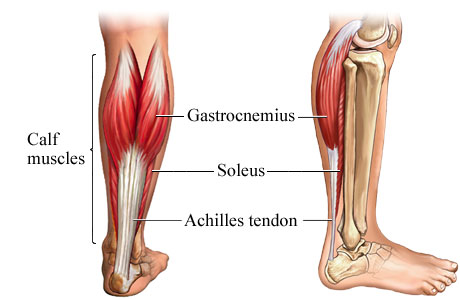What is Active Release Technique?
January 22, 2016Fitness and Rehabilitation: The Joint Journey
February 16, 2016 Calf pain when running is a common pathology yet there are numerous reasons behind your pain. Tight calf muscles tends to be most common amongst relatively new runners. This gives us a few clues already. It can be linked to a number of problems which can affect those new to the sport:
Calf pain when running is a common pathology yet there are numerous reasons behind your pain. Tight calf muscles tends to be most common amongst relatively new runners. This gives us a few clues already. It can be linked to a number of problems which can affect those new to the sport:
- A lack of flexibility in general
- Fatigued calf muscles
- Inappropriate footwear
- Wearing high heels daily
- Running too much, too soon
- Inadequate warm-up / cool-down
- Muscle imbalances elsewhere
- Running form
For some people, the calf muscles simply feel a bit tight the day after a long or hard run. For others, the tension affects them when running and can be so severe that the aching pain causes them to stop. But what causes it when there has been no previous injury and how can we prevent this pain?
Reduced flexibility
Some people are just naturally less flexible than others. Especially those that haven’t really trained a lot throughout their life or have taken a long break from exercise. The easiest way for this to be resolved is to stretch or foam roll, this allows the tissues to have better movement and can also increase your speed without changing the way you run. For stretching and rolling to be effective you should do this outside your training as well as warming up and cooling down properly with each run you do.
Fatigue
During your run you may feel like your calves are cramping or getting very stiff, this can be due to your body not being prepared for the amount of load and stress you are putting it through, sometimes we over do the run or step up the distances or speeds very quickly, commonly going from 5 to 10 kilometer runs within a few sessions as previous runs felt ‘easy’, this is an easy way to injury, we should always build strength and stability into our legs and accumulate distance safely to help get the body used to impact and prevent stress related injuries such as shin splints or tendonitis.
Inappropriate footwear
Training shoes are the most important part of your training, you should speak with a specialist and determine what you’re running in isn’t creating a bad running gait or putting pressure on your body which can be avoided. It’s important your day to day shoes are also comfortable and not hindering your running experience, high heels for instance can create a shorter calf muscle, which in turn will create problems when running as you won’t have as much dorsiflexion movement at your foot, this can lead to calf pain whilst running.
Training errors
Running too much, too soon can cause muscles to tighten up in response to the increased stress that they are not accustomed to. Ensure you warm-up before running with a pulse raiser that doesn’t stress the calf muscles – such as cycling or stepping. You can also stretch or roll your calf muscles before running, although research indicates that static stretching before exercise is not effective at reducing injury rates. But it’s really down to personal preference and I still stretch my calf and glute muscles before running as I know these are my problem areas! Do make sure you finish your run with a walk for 5 minutes and then a thorough stretching session, as this is where stretching really comes into its own to reduce post exercise soreness.
Muscle imbalances
Muscle imbalances are responsible for so many running injuries and having tight calf muscles whilst running is no exception. Everyone is different and so it is hard to tell you what may be affecting your particular case, but a really common pattern to look out for is tight hip flexors, leading to weak or mis-firing glutes. This results in a lack of hip extension when running and a bigger reliance on the calf muscles for propulsion. Remember, we’re like one big chain – so where the pain is isn’t necessarily where the problem is! A sports injury therapist should be able to assess you for muscle imbalances and determine what may be affecting you.
Form
Running form is basically the way you run and it is something that we don’t tend to think about when running, especially when we first start out. We just run however feels natural to us. However, your running form could play a big part in your calf muscle tightness and pain. It is important to have your form checked to make sure that you are in a correct pattern and not leading yourself into injury.
Finally, the most important part is to listen to your body, if you feel tired and fatigued then you may be doing too much exercise and not letting your body recover, this can lead to injury. It’s always important to enjoy what you do and vary your exercise routines to get the most out of it.
Adding a strengthening program to compliment your running is always an important part of developing your running exercise, this will prevent injury and can also help you become better and maybe more competitive in your running distances.

